Introduction
To summarize what we have discussed so far. We have defined the condition of psychosis which is a mixture of clinical conditions that include Schizophrenia, depression anxiety, Bipolar disorder, post traumatic stress disorder, delusional thinking, Hallucinations, mood and personality disorder, Narcolepsy (excessive daytime sleep), Perseveration (Uncontrolled repetition), Agitation, Aggression, Alogia (speech poverty), Avolition (no interest to do anything), Word salad (confused or unintelligible words or phrases), Reduced affect display (emotional blunting), Compulsive obsessive disorder, and even Autism. We also know that its cause is an array of social and biological factors including one of natures development strategies ‘Synaptic Pruning’.
Conventional medicine has identified dopamine and Serotonin pathways that, according to them are unbalanced, and the great work by Michael Gershon who has identified the way Serotonin is used in the body. We have also looked at modern medicine’s drug of choice to treat psychosis, the Dopamine D2 Antagonists anti-psychotropic drugs like Clozapine and anti-depressant SSRI (Selective Serotonin Reuptake Inhibitors) drugs like Prozac.

Finally we have discussed 2 case studies involving mass shootings at school. Eric Harris & Dylan Klebold the 2 boys that carried out the massacre. However, we discovered that the leader of the two, Eric Harris showed signs of cognitive disorder at an early age which escalated due to inadequate treatment of the disorder. Our second case study was Adam Lanza, who, again displayed cognitive and behavioral problems at an early age also did not receive the adequate treatment.
Statistics
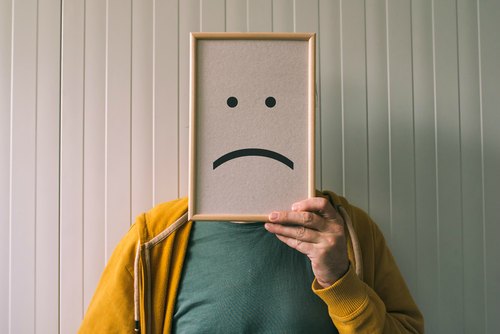
The world health organization report that around 300 million people live with depression and 260 million live with an anxiety disorder globally. In the US alone 44 million have had at least one cognitive disorder, while 2.4 million live with Schizophrenia, 6 million live with Bipolar disorder, 16 million live with severe depression, and 42 million live with anxiety disorder. Did you know that in 2002 11 million prescriptions were written for US Children and adolescents, but before 1990 it was almost prohibitive to drug children. Another sick situation is that now Prozac and Paxil come in mint and orange flavor liquids. In 2005 the sale of Zoloft ($3 billion) exceeded Tide washing detergent. What changed between 1990 and 2002??. It has become an adopted accepted practice to just medicate a child exacerbating the internal issues by suppressing the symptoms and ignoring the root cause.
Robert Whitaker in his book Àn anatomy of an epidemic`informs us that in 1955 there were 566,000 people in state and county mental hospitals, but only 355.000 had a psychotic disorder diagnosis which equated to 1 in 468 Americans who were hospitalized . In 1987 the FDA approved the use of the antidepressant (SSRI) drug Prozac, so by 2007 (2 decades later) the number of Americans diagnosed with some type of psychosis had soared to nearly 4 million (1 in 76). In 1955 there were 50,937 manic depressives (as it was known then) which today means depression and Bipolar disorder, and in 2105 16 million young adults (18 years or more) had at least one major depressive episode in the past year. The Depression and Bipolar support alliance (DBSA) organization reports that 5.7 million American Adults (2.6% of the US population) age 18 and older suffer bipolar disorder every year (Bipolar disorder causes unusual shifts in mood, energy and activity levels). In 1987 16,200 children under 18 were disabled by a serious disorder concerning brain activity, and by the end of 2007 this number had increased to 561.569. So in 20 years the number of children suffering with a mental disorder has increased 34 fold. What was approved in 1987…PROZAC…
The Social Fabric

Today many parents are talked into medicating their child
Although these articles are entitled ‘The destruction of Society’s social fabric, up to now I have not focused on this issue except for the case studies of the mass school shootings. If I thought that modern mechanisms such as medicating children who have trouble concentrating, as an effective replacement for ‘old school’ counseling between the parents, the schools counselor, teachers and the child then I would say continue. But these modern mechanisms of drugging the kids may appear initially that it’s improving their attention span, but overtime it is causing untold damage long term damage. Even some parents are being convinced by psychiatric therapists and teachers that prescribing stimulants such as Adderall or Ritalin is what is best for the anxious, fidgety child that has difficulty concentrating.
The Justification for Medication

In the documentary made by PBS in 2001 entitled ‘Medicating kids’ shows several families with children who are diagnosed with Attention Deficient Disorder (ADD) or Attention Deficit Hyperactivity Disorder (ADHD). The parents witness the failure of the child attempting to fit in with the social groups, and how their child is impulsive, disruptive to the other children and teachers, easily distracted and has a very short attention span. Early signs show up in Kindergarten and only escalate in middle school and in some cases the child is always in trouble, falls behind in his/her grades and becomes increasingly frustrated that they can’t excel no matter how hard they try.
What a Relief to Have a Diagnosis

In the eyes of the parents, to receive a diagnosis of ADD or ADHD from the psychiatrist is a sign of relief (like in the case of Eric Harris`s parents), and as soon as their child begins taking the drug they see a remarkable difference in some cases, the child’s behavior changes for the better, they become more attentive. The parents finally receive a renewed belief that their child might succeed. The child is able to conduct a conversation over dinner with its parents without a tantrum or complete uninterest. Once the parents and the child accept the various side effects for the first few days including insomnia, stomach ache, decreased appetite, and headaches everything is fine, and in their minds everything is back to normal..but it’s far from that.
Most college students are taking cognitive enhancement drugs

Statistics show that the number of children being prescribed anti-psychotic drugs between 1987 and 1996 tripled. Now normalcy is medicating children in many communities to the point that if an ADHD/ADD diagnosis is confirmed the supervisory adults such as psychologists, pediatricians, teachers, parents and counselors are seen as remiss if a prescription for a drug is not written ‘tout suite’. Ritalin and Adderall are common stimulants on college and University campuses providing heightened concentration and to provide the fuel for long hours of study. It is estimated that 80% of college students are consuming cognitive enhancement drugs while only 25% actually possess a valid prescription. As it is reported that most do not have ADD or ADHD but they simply tell their parents and their doctors that they are stressed and having trouble concentrating and ‘Bam’ instant prescription, so most parents and physicians are just fueling the fire, sweltering in their own ignorance of the potential damage they are inflicting.
Medicate behavior and mood and the Tearing of the Social Fabric of Society

In my opinion the social fabric is being undermined by dangerous mind altering hallucinogenic anti-psychotic drugs as an alternative to psychosocial ‘old school therapies. This is coupled with the widespread ignorance of adequate nutrition that would in the most part prevent most of these cognitive disorders. This ‘quick fix’ behaviour is exacerbated by social circumstances that are sometimes out of our control but nevertheless need to be changed. I mentioned these circumstances in Part 1 that include unemployment, social welfare benefits, single parent households and eating nutrition less food , most of the time out of necessity due to a limited budget. Dr Doris Rapp suggests that dietary management approach should be introduced by the parents for the child (if it were at all possible, since most parents do not possess the dietary knowledge to implement such a scheme). She also suggests that parents take a more active part in their childs life and zero in on the stressors that could be the root of their child’s problem. Dr Scott Shannon a holistic child psychiatrist agrees by saying that behavioral and emotional problems are far too often treated using drugs as opposed to what they really are- stressors that parents can learn to identify and eliminate from the child’s life where possible, or at least diminish it.
Are Antidepressants with Us or Against Us?

SERT (Serotonin Reuptake Transporter) Density and Depression
We know that the the SSRI drug in effect inhibits the serotonin transport and in turn inhibits reuptake,recycling and inactivation causing some serotonin receptors to desensitize and fail to respond anymore (irreparable damage), while others become less sensitive to stimulation by serotonin. It is the serotonin transporter that is key to the serotonin reuptake, recycling and inactivation. It is the SERT (Serotonin Reuptake Transporter) that gets hit by SSRI drug use, as evidenced by studies involving Zoloft which reduced SERT density by 15-30% in a rat Hippocampus after 4-10 days of dosing and by 80% after 15 days. Furthermore, in another experiment it was noted that an overexpression of genes that encode for SERT was caused by SSRI dosing of mice. It is the relationship of SERT density as an important modulator of mood, so by reducing the SERT density as SSRI’s do are amplifying depressive symptoms not lowering them.
The Brain Manufactures its Own Serotonin
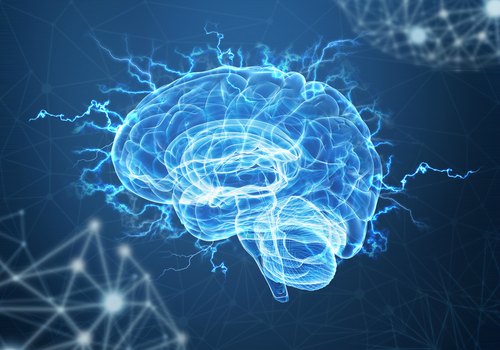
However, although approximately 95% of the serotonin is manufactured by our EC or Enterochromaffin cells in the gut, Serotonin required for the brain, is manufactured in the brain, since the Serotonin molecule is too large to cross the blood brain barrier. The brain is able to achieve this by picking up tryptophan contained in the bloodstream (you may remember that Tryptophan is an essential amino acid meaning the body is unable to manufacture it and we must get it from our diet from foods such as nuts,seeds, cheese,red meat, chicken, fish, oats, beans, lentils and eggs). Once the tryptophan has crossed the blood brain barrier it enters midbrain neurons referred to as the ‘Dorsal Raphe Nucleus’ and the `Median Raphe Nucleus`(shown in the diagram below `Serotonin and Dopamine distribution within the brain`). Within the neuronal cell bodies Tryptophan is converted into Serotonin (5HT), and then distributed throughout the brain (Blue distribution lines on diagram). Research has identified some of these receptors including 5HT1A (locations: Amygdala, entorhinal cortex, hippocampus, hypothalamus, raphe nuclei, septum) and 5HT7 (locations: Frontal cortex astrocytes, and smooth muscle cells in blood vessels) for example.
Diagram 1 Serotonin & Dopamine distribution in the brain:
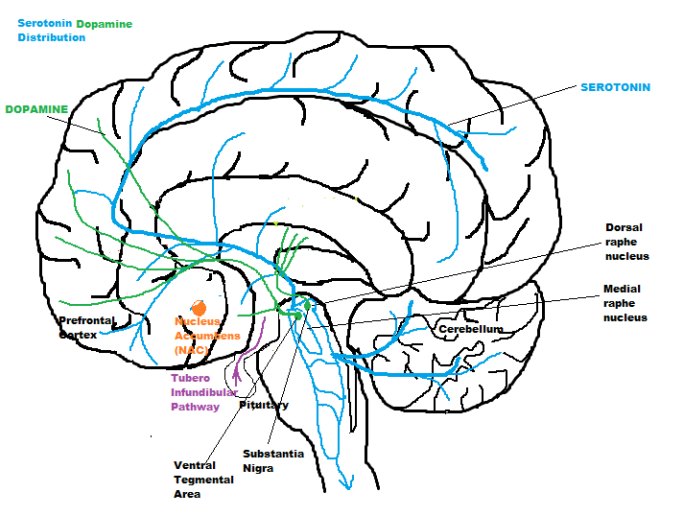
The Brain Manufactures its own Dopamine
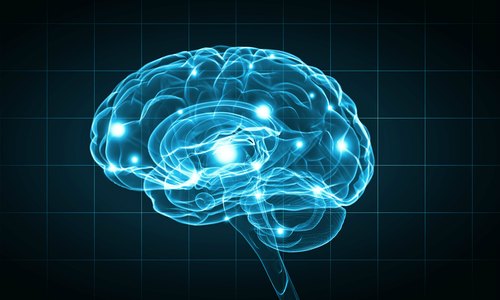
Dopamine is manufactured in the Ventral Tegmental area and the Substantia Nigra (green distribution lines on the diagram). In order for these 2 areas to produce Dopamine it requires either tyrosine or Phenylalanine (an essential amino acid) which is used to synthesize tyrosine (a non-essential amino acid). Foods containing Tyrosine and Phenylalanine include nuts,seeds, cheese,red meat, chicken, fish, oats, beans, and eggs and Yoghurt.
Conventional Medicine and Levodopa
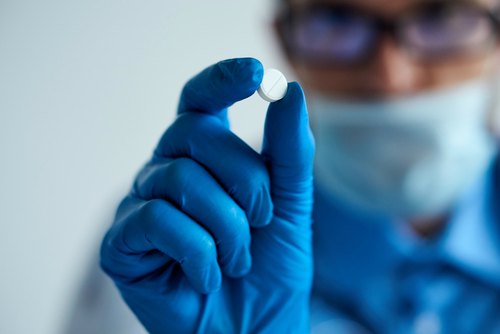
Allopathic conventional medicine believe that diseases of the nervous system are associated with dysfunction of the dopamine system like Parkinson`s disease which they believe is a loss of dopamine secreting neurons initiated from the Substantia Nigra so they prescribe Levodopa, a dopamine precursor that has the following side effects:
- Abnormal thinking: holding false beliefs that cannot be changed by fact
- agitation
- anxiety
- clenching or grinding of teeth
- clumsiness or unsteadiness
- confusion
- difficulty swallowing
- dizziness
- excessive watering of mouth
- false sense of well being
- feeling faint
- general feeling of discomfort or illness
- hallucinations (seeing, hearing, or feeling things that are not there)
- hand tremor, increased
- nausea or vomiting
- numbness
- unusual and uncontrolled movements of the body, including the face, tongue, arms, hands, head, and upper body
- unusual tiredness or weakness
The reason that your body is not absorbing dietary dopamine precursor such as Tyrosine and/or Phenylalanine is probably a gut and/or lack of stomach acid and/or Vitamin D3 deficiency, so fix the diet, the Vitamin D3 deficiency and increase your stomach acid (ensure you add salt to your diet and apple cider vinegar). Why would you take this drug and suffer with the side effects. Most anti-psychotic drugs are used to treat schizophrenia, ADHD etc due to their belief that these conditions are caused by altered levels of dopamine (yes of course Doctor…its a SYMPTOM not a cause..how many more times must I repeat myself).
Conclusions
We can conclude that the extent of children whose parents condone the actions of physicians and psychiatrists who are reluctant, for whatever reason, to analyze the problems with a child and are too ready to simply suppress the symptoms with an anti-psychotic drug. The evidence is clear and I believe the escalation of the number of children suffering with a mental disorder which in1987 was 16,200 children and in 2007 561,569 is due to over-medication. This is shameful and apart from few scattered alternative medical practitioners, the American Medical Association nor the American Psychiatric Association is lifting a finger to change this disgraceful situation.

The stupid neither forgive nor forget; the naive forgive and forget; the wise forgive but do not forget.
People often say that this or that person has not yet found himself. But the self is not something one finds, it is something one creates.
If the dead talk to you, you are a spiritualist; if God talks to you, you are a schizophrenic.
-Quotes from Thomas Szasz (1920-2012)
References/Acknowledgments:
- Bipolar Disorder DBSA (Depression & Bipolar Support Alliance)
- Mother`s little helper The History & Evolution of Amphetamines Tony Rich & Meg Jordan 2015
- Anatomy of an Epidemic Robert Whitaker Book 2015
- Dorsal Raphe Nucleus Wikipedia
- Rethinking Psychiatric drugs Grace Jackson Book 2005
- Levodopa Drugs.com
- Quotes from Thomas Szasz Brainyquote
About The Author: Eric Malouin
In terms of my heritage I am not a thoroughbred, I am half English from England and half French Canadian from Quebec. Having spent the last 10 years in Medical research I thought that it was time to share my passion for true health to anybody interested in maintaining health without using conventional medicine. Once in the distant past I lived off conventional grocery shelves until you visit the man in the white coat and then a light shines through the darkness that you had not realized you were in… I was in..the twilight zone….I cured my own problems using natural methods, although they were not a big deal since I have always exercised..jogging every morning and tennis 12 hours/week, swimming but I was eating a lot of devil food that was causing my body to become unbalanced..an easy fix..reprogrammed my taste buds and gave the food back to the devil…lol
I hope you enjoy the articles……
Regards,
Eric
Contact the Author: emalouin@gmail.com